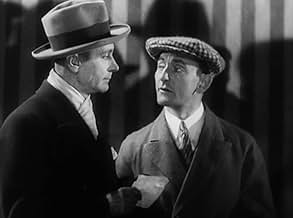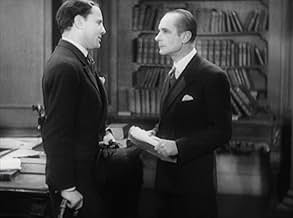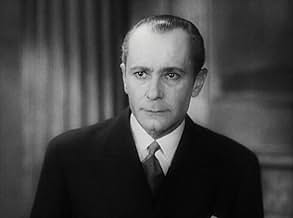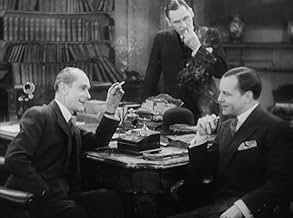Mary
- 1931
- 1h 18min
VALUTAZIONE IMDb
5,7/10
1078
LA TUA VALUTAZIONE
Aggiungi una trama nella tua linguaA juror in a murder trial, after voting to convict, has second thoughts and begins to investigate on his own before the execution.A juror in a murder trial, after voting to convict, has second thoughts and begins to investigate on his own before the execution.A juror in a murder trial, after voting to convict, has second thoughts and begins to investigate on his own before the execution.
- Regia
- Sceneggiatura
- Star
John Mylong
- John Stuart
- (as Jack Mylong-Münz)
Recensioni in evidenza
For Hitchcock completists only, this German-language version of the same director's Murder! tells the same story on the same sets, but with different cast, as a juror questions the guilty verdict he helped come to.
A few mildly amusing visual flairs are present here: jurors seated around a circular table. The camera pans along and we see a first juror held deep in thought; the next several are listening with rapt attention; until we arrive at one man who is clearly bored to tears with it all; a mild joke which was thrown in to the German version, not in the UK version. Brief glimpses (again) of cross-dressing, which Hitch later went back to, in a big way, with Psycho.
Some early quick cuts are surprising, eleven cuts in a three seconds-long scene at the twenty three minute mark. Most unconventional at the time.
Overall the movie is watchable, but not very involving, partly at least due to its lax pacing, and a verbose screenplay. Like its UK counterpart, however, it does pick up for its memorable climax.
A few mildly amusing visual flairs are present here: jurors seated around a circular table. The camera pans along and we see a first juror held deep in thought; the next several are listening with rapt attention; until we arrive at one man who is clearly bored to tears with it all; a mild joke which was thrown in to the German version, not in the UK version. Brief glimpses (again) of cross-dressing, which Hitch later went back to, in a big way, with Psycho.
Some early quick cuts are surprising, eleven cuts in a three seconds-long scene at the twenty three minute mark. Most unconventional at the time.
Overall the movie is watchable, but not very involving, partly at least due to its lax pacing, and a verbose screenplay. Like its UK counterpart, however, it does pick up for its memorable climax.
If you only speak German, you should watch this version. If you speak English, you should just watch Alfred Hitchcock's film Murder! (1930) because it's exact same movie, using the exact same sets and plot, just with different actors.
Is it merely a German version of Hitchcock's "Murder!"? True both films are based on the same source-material. Yet the outcome is different. There is more emphasis on choice of camera and shots and editing in the German film than in the British one. The underlying cross dressing and gay aspects are more obvious in the German film. Yes "Mary'' can be considerably compared to Lumet's "12 Angry Men" made decades
later. Here the juror becomes the detective, while in Lumet's film the juror never really leaves the jury room. The relationship between juror and the accused is explored midway--a rare aspect in any jury-oriented tale. It is therefore goes one up on "Murder!" Further, Alfred Abel (a German actor) is superior to Herbert Marshall both playing the same character of the same tale, that of Sir John Menier. So is Olga Tschechowa playing the role of the accused actress, facing death sentence.
It is late night when the dwellers of a street hear a scream in the apartment of the actress Mary Baring (Olga Tschechowa). A police officer arrives, and the neighbors see Mary dazed and confused, with blood on her clothes and on a poker, and the body of her colleague Ellen Moore on the floor. An empty bottle of brandy is on the table and Mary is in shock with no recollection of what happened. The drunken Mr. Moore says that Mary and Ellen were rivals in the theater and the police take Mary to the precinct. There is a trial, and the jurors believe Mary is guilty, but the famous actor Sir John Menier (Alfred Abel) believes she is not guilty. However, he is not able to change the position of the other jurors and is forced to change his vote to guilty. Mary is sentenced to the gallows, but Sir John decides to conduct his own investigation to prove that Mary is innocent.
"Mary" (1931) is a German spoken remake of "Murder!" (1930) that was shot simultaneously on the same sets of "Murder!" by Alfred Hitchcock with a German-speaking cast. The plot is interesting, about a murder and the woman accused and considered guilty by the jurors. There is one moment, when Sir John Menier exposes his opinion, that seems to be the inspiration to "12 Angry Men" (1957) when only one juror disagrees from the others. The real killer is a weird guy, wearing a dress to perform at the circus. After watching "Mary", I have finally finished to see or see again all the Alfred Hitchcock features and written a review in IMDb for each one. My vote is seven.
Title (Brazil): "Mary"
"Mary" (1931) is a German spoken remake of "Murder!" (1930) that was shot simultaneously on the same sets of "Murder!" by Alfred Hitchcock with a German-speaking cast. The plot is interesting, about a murder and the woman accused and considered guilty by the jurors. There is one moment, when Sir John Menier exposes his opinion, that seems to be the inspiration to "12 Angry Men" (1957) when only one juror disagrees from the others. The real killer is a weird guy, wearing a dress to perform at the circus. After watching "Mary", I have finally finished to see or see again all the Alfred Hitchcock features and written a review in IMDb for each one. My vote is seven.
Title (Brazil): "Mary"
The Hitchcock/Truffaut book,which is actually a very long interview ,something like "the Beatles anthology" in pop music ,gives us many interesting informations about "Mary" ,a movie the master liked.Although he told Truffaut he detested the whodunits ,those riddles a la Agatha Christie,"Mary" featured "things we did for the first time":stream of consciousness,play in the play a la "Hamlet" references to transvestism and even hints at (veiled) homosexuality,which was a "crime" in Great Britain as it was in Germany at the time....
That said,the story drags on a bit and the running time could have been boiled down to one hour,which would have enhanced the really good scenes: IT was Herbert Marshall's first talkie and the scene when he's shaving and thinking for a clue renews the way the detective investigates.The unfinished manuscript is also a very good idea.But the bravura passage remains the final circus.One can also note the scene of the verdict we hear from the empty juror's room.
There are elements which would appear later in Hitchcock's work: the theater ("Stage fright",also a whodunit,btw),of course "Psycho" (a man in drag) and "vertigo" (the finale which makes you feel dizzy).
This is another early Hitchcock which is not only for completists.
That said,the story drags on a bit and the running time could have been boiled down to one hour,which would have enhanced the really good scenes: IT was Herbert Marshall's first talkie and the scene when he's shaving and thinking for a clue renews the way the detective investigates.The unfinished manuscript is also a very good idea.But the bravura passage remains the final circus.One can also note the scene of the verdict we hear from the empty juror's room.
There are elements which would appear later in Hitchcock's work: the theater ("Stage fright",also a whodunit,btw),of course "Psycho" (a man in drag) and "vertigo" (the finale which makes you feel dizzy).
This is another early Hitchcock which is not only for completists.
Lo sapevi?
- QuizA copy of the film is included as a bonus feature on the Kino Lorber Studio Classics DVD and German DVD releases of Omicidio! (1930) and the French DVD release of La taverna della Giamaica (1939).
- BlooperAs Sir John interviews Mary in jail, it is established in long-shot that both are sitting at opposite ends of a long table. During frontal closeups, the widths of the planks that make up the tabletop reveal that very randomly either the table is turning between shots or both persons repeatedly switch places.
The exact same continuity error also applies to the American version of the movie, Omicidio! (1930).
- ConnessioniAlternate-language version of Omicidio! (1930)
I più visti
Accedi per valutare e creare un elenco di titoli salvati per ottenere consigli personalizzati
Dettagli
- Data di uscita
- Paesi di origine
- Lingua
- Celebre anche come
- Secreto de la noche
- Luoghi delle riprese
- Azienda produttrice
- Vedi altri crediti dell’azienda su IMDbPro
- Tempo di esecuzione1 ora 18 minuti
- Colore
- Proporzioni
- 1.20 : 1
Contribuisci a questa pagina
Suggerisci una modifica o aggiungi i contenuti mancanti
































